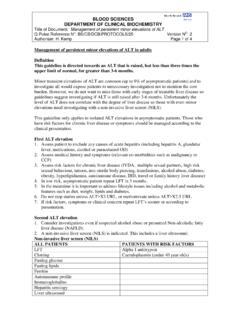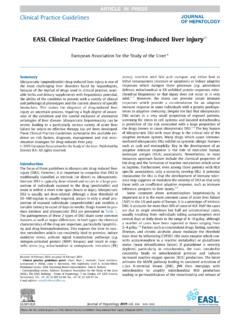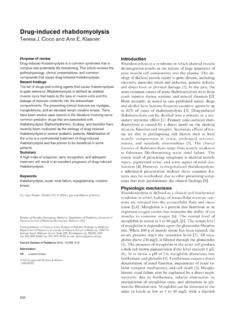Transcription of DRUG NAME: Ribociclib - BC Cancer
1 Ribocliclib DRUG NAME: Ribociclib SYNONYM(S): LEE0111. COMMON TRADE NAME(S): KISQALI . CLASSIFICATION: molecular targeted therapy Special pediatric considerations are noted when applicable, otherwise adult provisions apply. MECHANISM OF ACTION: Ribociclib is an orally administered, selective, reversible small molecule inhibitor of cyclin-dependent kinases (CDK). 4 and 6. CDK 4/6 form complexes with cyclin D to promote phosphorylation of retinoblastoma (Rb) protein, which allows cell cycle progression. Ribociclib is cell cycle phase-specific, blocking transition from the G1 to the S phase 2-4. by binding to CDK 4/6 to inhibit Rb protein phosphorylation. Ribociclib is an immunosuppressive agent. PHARMACOKINETICS: Oral Absorption time to peak: 1-4 h; steady state after 8 days Distribution equally distributed between red blood cells and plasma cross blood brain barrier?
2 Unlikely (based on rat models). volume of distribution 1,090 L. plasma protein binding 70%. Metabolism extensive hepatic metabolism via CYP 3A4. active metabolite(s) negligible inactive metabolite(s) numerous, including M1, M4, M13. Excretion mainly fecal elimination urine 23% (12% parent drug, 4% M4). feces 69% (17% parent drug, 14% M4). 3. terminal half life 30-55 h clearance 26 L/h Adapted from standard reference2 unless specified otherwise. USES: Primary uses: Other uses: *Breast Cancer *Health Canada approved indication SPECIAL PRECAUTIONS: Contraindications: untreated congenital long QT syndrome or QTc 450 ms at baseline 2.. BC Cancer Drug Manual All rights reserved. Page 1 of 6 Ribociclib This document may not be reproduced in any form without the express written permission of BC Cancer Provincial Pharmacy.
3 Developed: 1 December 2018. Revised: 1 October 2020. Ribocliclib Caution: QT interval prolongation has been reported; caution in patients with known risk factors. Correct preexisting electrolyte disturbances and monitor ECG and electrolytes. Administer Ribociclib in the morning as QT prolongation 2,5. risk may be increased when it is taken in the evening (due to bradycardia which naturally occurs during sleep). Carcinogenicity: no information found 2. Mutagenicity: Not mutagenic in Ames test or in a mammalian in vivo mutation test. 2. Fertility: In animal studies, seminiferous tubule degeneration and reduced luminal sperm were observed. Pregnancy: In animal studies, lower fetal weights and an increased incidence of fetal malformations and variants were observed.
4 For females of reproductive potential, pregnancy testing is recommended prior to initiating treatment. 2. Contraception should be used during treatment and for at least 21 days after the last dose of Ribociclib . Breastfeeding is not recommended due to the potential secretion into breast milk. Women may begin breastfeeding 2. 21 days after the last dose of Ribociclib . SIDE EFFECTS: The table includes adverse events that presented during drug treatment but may not necessarily have a causal relationship with the drug. Because clinical trials are conducted under very specific conditions, the adverse event rates observed may not reflect the rates observed in clinical practice. Adverse events are generally included if they were reported in more than 1% of patients in the product monograph or pivotal trials, and/or determined to be 6.
5 Clinically important . When placebo-controlled trials are available, adverse events will generally be included if the incidence is >5% higher in the treatment group. Incidence data based on combination therapy (instead of monotherapy) is indicated with an asterisk (*) where applicable. ORGAN SITE SIDE EFFECT. Clinically important side effects are in bold, italics 7-9. blood and lymphatic anemia (26-44%, severe 3-6%). system/ febrile 8. febrile neutropenia (12%, severe 12%). neutropenia 7,8. leukopenia (43-100%, severe 17-82%). 7,8. lymphopenia (24-82%, severe 16-53%). 7,8. neutropenia (46-94%, severe 27-76%). 7-9. thrombocytopenia (30-71%, severe 8-28%). 10. gastrointestinal emetogenic potential: low 8. constipation (12%). 7,8. diarrhea (12-23%, severe 2%).
6 7,9. nausea (25-42%, severe 2%). stomatitis* (10-12%, severe 1%). 2,3,11. 7,8. vomiting (26-41%). 2,11. general disorders and edema, peripheral* (5-15%, severe <1%). administration site 7-9. fatigue (12-45%, severe 2-3%). conditions 8. pyrexia (18%).. BC Cancer Drug Manual All rights reserved. Page 2 of 6 Ribociclib This document may not be reproduced in any form without the express written permission of BC Cancer Provincial Pharmacy. Developed: 1 December 2018. Revised: 1 October 2020. Ribocliclib ORGAN SITE SIDE EFFECT. Clinically important side effects are in bold, italics hepatobiliary hepatotoxicity * (2%, severe 2%); see paragraph following Side Effects table 3,12. infections and infection* (35-50%, severe 4%) ; see paragraph following Side Effects table infestations 2,11.
7 Investigations ALT increase* (12-46%, severe 5-10%) ; see paragraph following Side Effects table 9. AST increase (16%, severe 3%) ; see paragraph following Side Effects table 2,3. bilirubin increase* (1-5%, severe 1%) ; see paragraph following Side Effects table 7,8. creatinine increase (11-41%). 3,11. gamma-glutamyltransferase increase* (5-52%, severe 2%). 7,8. QT interval prolongation (11-41%, severe 2-12%) ; see paragraph following Side Effects table 7,9. metabolism and nutrition appetite decrease (10-19%, severe 3%). 2,3. hypocalcemia* (2-5%, severe 2%). 3. hypoglycemia* (23%). hypokalemia* (11%). 8,9. hypophosphatemia (12-13%, severe 6%). 9. musculoskeletal and asthenia (13%). connective tissue 2,3. nervous system syncope* ( 3%, severe 2%).
8 13. respiratory, thoracic and interstitial lung disease/pneumonitis (<1%; severe <1%); sometimes fatal mediastinal 2,3. skin and subcutaneous alopecia* (19-33%). tissue 2,3,11. pruritus* (9-20%, severe <1%). 2. rash* (13-23%, severe <1%). vascular pulmonary embolism* (1%, severe 1%). Adapted from standard reference2 unless specified otherwise. Increases in ALT and/or AST have been reported. Grade 3/4 elevations mainly occur during the first six months of treatment and are usually reversible upon discontinuation of Ribociclib . Rarely, transaminase elevations greater than three times the upper limit of normal (ULN) can occur together with bilirubin increases greater than two times the ULN with normal alkaline phosphatase levels and without cholestasis.
9 Recovery to normal is expected after permanent discontinuation of Ribociclib . hepatotoxicity has also been reported, including hepatocellular injury and drug- induced liver injury. Monitor liver function tests at baseline and throughout treatment. Patients may require 2. Ribociclib dose reduction, interruption, or permanent discontinuation to manage hepatoxicity. Neutropenia is commonly reported and can occur from cycle 1 onward. The median time to first neutropenic 2. episode is 16 days, with a median duration of 15 days for grade 3 or greater neutropenia. Unlike neutropenia associated with traditional chemotherapy, neutropenia induced by Ribociclib is reversible, noncumulative, and is not 4. commonly associated with fever. Ribociclib treatment may need to be interrupted, dose reduced, or discontinued for 2.
10 Grade 3 or 4 neutropenia and/or infection. QTc interval prolongation has been reported and has (rarely) lead to fatalities; avoid concurrent therapy with drugs that increase risk. For all patients, electrolyte and ECG monitoring is advised at baseline and at regular intervals.. BC Cancer Drug Manual All rights reserved. Page 3 of 6 Ribociclib This document may not be reproduced in any form without the express written permission of BC Cancer Provincial Pharmacy. Developed: 1 December 2018. Revised: 1 October 2020. Ribocliclib Maximal QT/QTc prolongation is expected during days 8-21 of a 28 day cycle. If the QTc interval increases to more than 480 ms, Ribociclib should be held. Once the QTc interval resolves to 480 ms or less, Ribociclib may be resumed, however, adjustment to a lower dose level may be required.














